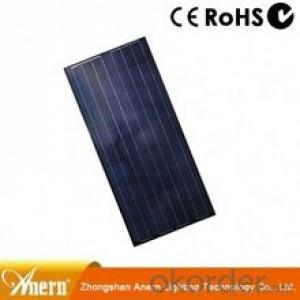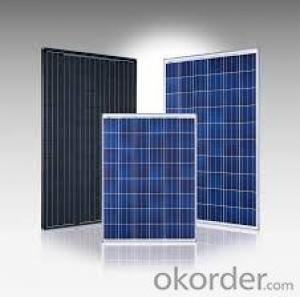250W Poly Silicon Solar Module with High Quality CNBM
- Loading Port:
- Qingdao
- Payment Terms:
- TT OR LC
- Min Order Qty:
- 10 set
- Supply Capability:
- 300000 set/month
OKorder Service Pledge
OKorder Financial Service
You Might Also Like
Quick Details
| Place of Origin: | China (Mainland) | Brand Name: | CNBM | Model Number: | 285W solar module |
| Material: | Polycrystalline Silicon | Size: | 1956*992*50mm | Number of Cells: | 72 |
| Max. Power: | 285W | Cell Size(mm): | 156*156 | Tolerance: | 0~3% |
| Cells Number(pcs): | 6*12 | Weight(Kg): | 25 | Max.Series Fuse Rating (A): | 15 |
| Max.System Voltage-IEC(V): | 1000 |



Polycrystalline Solar Module
XH250P(72)/ XH275P(72)/ XH300P(72)
Models | XH250P(72) | XH285P(72) | XH300P(72) |
Max. Power (Pmax) | 250Wp | 285Wp | 300Wp |
Optimum Operating Voltage (Vm) | 34.8V | 35.7V | 35.9V |
Optimum Operating Current (Im) | 7.18A | 7.77 A | 8.08A |
Open-circuit Voltage (Voc) | 43.8V | 35.4 V | 44.4V |
Short-circuit Current (Isc) | 8.04A | 8.24 A | 8.62A |
Cells efficiency | 14.6% | 15.8% | 16.8% |
Dimension L×W×H (mm) | 1956×992×50mm | 1956×992×50 | 1956×992×50 |
Power Tolerance (Pmax) | 0 ~ +3% | 0 ~ +3% | 0 ~ +3% |
Numbers of cells | 60pcs poly solar cell 156×156mm | 72pcs poly solar cell 156×156mm | 72pcs poly solar cell 156×156mm |
weight | 25kg | 25kg | 25kg |
Max system voltage | 1000V DC | 1000V DC | 1000V DC |
Temperature cycling range | -40℃ ~ +85℃ | -40℃ ~ +85℃ | -40℃ ~ +85℃ |
- Q:What is the history of solar cell development?
- The history of solar cell development dates back to the 19th century when the photovoltaic effect was first discovered by French physicist Alexandre-Edmond Becquerel in 1839. However, it wasn't until 1954 that the first practical silicon solar cell was developed by Bell Labs scientists. This breakthrough led to the commercialization of solar cells and their initial use in space applications, such as powering satellites. Throughout the 1960s and 1970s, solar cell technology continued to advance, primarily driven by research and development efforts in the United States. The energy crisis of the 1970s further fueled interest in renewable energy, including solar cells, leading to increased investment and technological advancements. In the 1980s and 1990s, solar cells became more efficient and affordable, making them increasingly popular for off-grid applications, such as powering remote locations and providing electricity to rural communities. Governments and organizations worldwide started implementing policies and incentives to promote solar energy adoption. In the early 2000s, there was a significant growth in the solar industry, driven by technological improvements, increased manufacturing scale, and declining production costs. This led to the widespread adoption of solar panels for residential and commercial use, as well as grid-connected solar power plants. Today, solar cells continue to evolve, with ongoing research focused on improving efficiency, durability, and reducing costs. The integration of solar cells into various applications, such as building materials and consumer electronics, further expands their potential. The solar industry plays a crucial role in the global shift towards clean and sustainable energy sources.
- Q:Can anybody tell me how to make a solar cell at home?
- I can, let me send you the instructions.
- Q:How can I calculate the cost of using solar cells if I put a fully-functional solar system in my house?
- Oh gosh, that would a lot, are you really ready to see your bill?
- Q:Can solar cells be used for powering remote communication towers?
- Yes, solar cells can indeed be used to power remote communication towers. Solar cells, also known as photovoltaic cells, convert sunlight into electricity, making them an ideal and sustainable solution for remote locations where traditional power sources may be unavailable or impractical. The consistent exposure to sunlight enables solar cells to generate electricity to power communication equipment, including antennas, transmitters, and receivers, ensuring uninterrupted connectivity in remote areas. Additionally, solar cells can be paired with battery storage systems to store excess energy generated during the day, providing a reliable power supply for communication towers even during nighttime or cloudy conditions.
- Q:What is the impact of bird collisions on solar cell performance?
- Bird collisions can have a negative impact on solar cell performance. When birds collide with solar panels, they can cause physical damage to the cells, leading to reduced efficiency and power output. Additionally, bird droppings and debris left behind can create shading and block sunlight from reaching the cells, further decreasing their performance. Therefore, preventing bird collisions is important to ensure optimal functioning and longevity of solar panels.
- Q:What is the role of bypass diodes in solar cell systems?
- The role of bypass diodes in solar cell systems is to prevent the loss of power due to shading or damage to individual solar cells. These diodes provide an alternate pathway for the flow of current, allowing the unaffected cells to continue generating electricity even if some cells are blocked or not functioning optimally. By minimizing the impact of shading or cell failure, bypass diodes help to maintain the overall efficiency and performance of the solar cell system.
- Q:I would like to use a ppt to show how solar cells can work in a power generation factory, can anybody share some useful information with me?
- The idea behind solar cells is we basically using the free electricity from the sun.
- Q:Can solar cells be used for powering agricultural irrigation systems?
- Yes, solar cells can be used to power agricultural irrigation systems. Solar panels can convert sunlight into electricity, which can then be used to power pumps and other equipment required for irrigation. This renewable energy source provides a sustainable and cost-effective solution for powering agricultural irrigation systems, particularly in areas with abundant sunlight.
- Q:How do solar cells perform in different climates?
- Solar cells can perform well in various climates, although their efficiency may vary. In regions with abundant sunlight and higher temperatures, solar cells can generate more electricity. However, extreme heat can slightly reduce their efficiency. In colder climates, solar cells can still produce electricity, although their output may be lower during winter months due to reduced sunlight. Overall, solar cells can function effectively in different climates, but the specific performance may depend on the local weather conditions.
- Q:Can solar cells be used in railway applications?
- Yes, solar cells can be used in railway applications. They can be installed on railway tracks, train roofs, or station roofs to generate electricity and power various railway systems, such as signaling, lighting, and communication systems. Additionally, solar cells can also be used to charge batteries in trains or provide power for onboard equipment, reducing reliance on traditional sources of energy and promoting sustainability in the railway industry.
1. Manufacturer Overview |
|
|---|---|
| Location | |
| Year Established | |
| Annual Output Value | |
| Main Markets | |
| Company Certifications | |
2. Manufacturer Certificates |
|
|---|---|
| a) Certification Name | |
| Range | |
| Reference | |
| Validity Period | |
3. Manufacturer Capability |
|
|---|---|
| a)Trade Capacity | |
| Nearest Port | |
| Export Percentage | |
| No.of Employees in Trade Department | |
| Language Spoken: | |
| b)Factory Information | |
| Factory Size: | |
| No. of Production Lines | |
| Contract Manufacturing | |
| Product Price Range | |
Send your message to us
250W Poly Silicon Solar Module with High Quality CNBM
- Loading Port:
- Qingdao
- Payment Terms:
- TT OR LC
- Min Order Qty:
- 10 set
- Supply Capability:
- 300000 set/month
OKorder Service Pledge
OKorder Financial Service
Similar products
New products
Hot products
Hot Searches
Related keywords



























